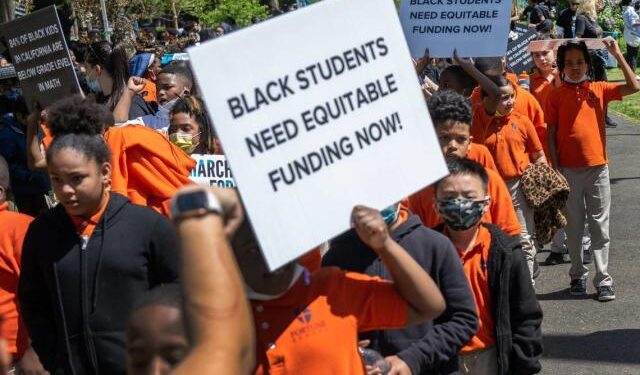Img source: www.yahoo.com
May 31, 2024 Story by: Editor
Seventy years after the Brown v. Board of Education decision ended racial segregation in public schools, Black students in California continue to face significant disparities in educational opportunities and outcomes. New findings previewed in Sacramento this week highlighted these ongoing issues.
“Whether you’re a parent, a student, or an educator, the promise of Brown v. Board has not been reached,” stated Amir Whitaker, policy counsel at the American Civil Liberties Union of Southern California and author of the State of Black Education 2024 California Report Card.
In a legislative hearing room on N Street with the State Capitol in the background, Black educators, lawmakers, parents, and students discussed the persistent challenges and necessary solutions. The complete report will be released in the fall, but the May preview revealed ongoing gaps, frustration, and calls for new actions to address these issues.
“We want a 21st century, multiracial learning community, not a social control system. We need a well-funded curriculum that’s reflective of us,” said Carl Pinkston, operations director of the Sacramento-based Black Parallel School Board. “We need Black teachers. We need a whole new way of looking at the educational system.”
“Our kids are at the top of the charts for the highest disparities. We look good in the worst ways possible, not only in Stockton, but in the state of California,” added Karesha Boyd, chair of Stockton Unified School District’s Black Parent Advisory Committee. “When we’re executing the plan for Black education, we need to execute on reinventing what education looks like for us as a community.”
Key findings from state, federal, and local education data include:
- Only 17% of Black students met or exceeded the state’s math assessment standards in the 2022-2023 school year, compared to nearly half of white students. For English, 30% of Black students met the standards, while six in 10 white students did.
- About 78% of Black students graduated high school in 2023, compared to 90% of white students. However, the college enrollment rate for Black students dropped to 55%, compared to 68% for white students.
- Less than 4% of California’s teachers are Black, though Black students represent over 5% of the state’s K-12 enrollment.
- Approximately 37% of Black students in California were chronically absent in the 2022-2023 school year, compared to 20% of white students.
Representation in the Classroom
Kalani Griffith, a sophomore at River City High School in West Sacramento and a youth senator with Black Students of California United, emphasized the importance of increasing the number of Black teachers. In a state where just 3.8% of teachers are Black, Griffith suggested that opening more community schools with access to educational, mental health, and other resources could make a significant difference.
“Us Black students, we need to see more teachers who look like us, to go to for support,” Griffith said. “There’s not a lot of adults who look like us in school who can help us succeed.”
For the past seven years, Whitaker has focused on the disparities faced by Black students and families in California and nationwide, linking historical injustices to current inequalities. This work aligns with the efforts of lawmakers in the California Legislative Black Caucus, who are advocating for historic reparations legislation for Black Californians.
“We need to get past that misnomer, that misinformation, that we don’t value education. That’s the farthest thing from the truth,” said State Senator Steven Bradford, D-Gardena, and vice chair of the California Legislative Black Caucus. “For over 250 years, we were tortured, sometimes even killed, for trying to learn how to read and write.
“If we know the truth about this country and about African-Americans, we’ve always valued education, but it’s always been a struggle to get that education,” Bradford continued. “We’ve had to go through more obstacles than anyone else just to get educated.”
The two years of work by a specially convened Reparations Task Force has paved the way for current legislation. A crucial element of their recommendations is investing in the state’s Black students. Task force members urged lawmakers to ensure that African-American students in California have every educational resource, support, and intervention needed to eliminate racial disparities and permanently close the opportunity gap.
“You have a right to your education,” said Assemblymember Mia Bonta, D-Oakland, a member of the California Legislative Black Caucus and the Assembly’s Education Committee. “We, as a Black community, have a right to ensure that we have the ability to be educated, to thrive, to not have to suffer the outcomes that show the disparities in experiences every single day.” Source: The Sacramento Bee

















